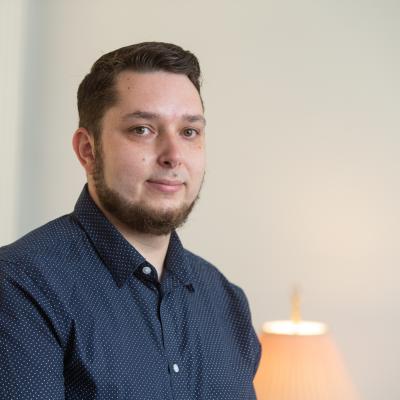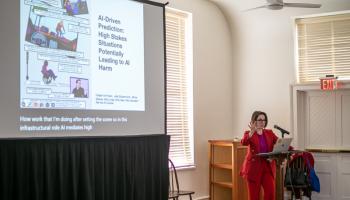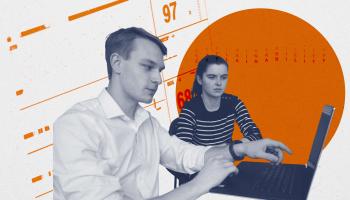Harnessing AI in Higher Education

Following a study challenging the belief that older adults are more susceptible to online misinformation generated by artificial intelligence, a UVA professor is working to establish a teaching and research initiative on Grounds that will identify ways to integrate AI and large language models into research and the classroom and to further study factors influencing individuals’ ability to distinguish between real and AI-generated content.
In a paper published in June of this year, which was widely cited in the national media by publications like Science Magazine and Scientific American and Forbes, Hudson Golino, an associate professor in the College’s Department of Psychology, and his co-authors announced that they had developed a test known as the Misinformation Susceptibility Test, or MIST, the first instrument of its kind to offer a highly validated measure of an individual’s ability to tell fake news from the real thing.

The test offers respondents the opportunity to identify which among a set of headlines were drawn from real news sources and which were generated by large language models, or LLMs, like ChatGPT, which are generative AI algorithms capable of recognizing and generating textual content in human language.
Contrary to the findings of earlier studies claiming that older individuals are more vulnerable to being misled by fake news, Golino and his coauthors’ analysis of nearly 9,000 test participants, suggests instead that participants aged 18-29 are consistently less effective at distinguishing real news from fake than those aged 65 or older. Findings from their study also suggest that people who spend nine or more hours of recreational time online every day and those who use social media as their primary news source were less effective at spotting AI-generated headlines.
Understanding why younger people are more susceptible to manipulation by fake news requires further study, according to Golino, whose work in psychometrics is focused on understanding human behavior and cognition through scientific observation and prediction. One reason, Golino speculated, may be because they spend more time on social media, and they are, simply, more exposed to it. However, Golino added, it may be a result of the fact that our capacity to deal with information based on experience and acquired information and vocabulary improves as we age and as we learn.
The good news, Golino said, is that it’s possible to teach people to be more discerning consumers of information by teaching them to recognize how they can be manipulated by misinformation.
“The easiest kind of misinformation to identify is fear mongering,” Golino explained. “For example, in Brazil over the past six years, the right-wing candidate was instilling fear in the population by saying ‘If you don’t vote for me, Brazil will become a communist state.’ The left-wing candidate was doing exactly the same thing, saying ‘If you don’t vote for me, democracy is dead.’ This is fear mongering. Neither statement is true. Brazil won’t become a communist country overnight, and neither will its democracy die overnight just because you voted for a specific candidate. When you teach people to identify these strategies, they become better at moments in which information is being used to manipulate them.”
Having an effective instrument like MIST for measuring susceptibility to misinformation will allow researchers to develop better methods for understanding who is most at risk and how to help them avoid being victims of manipulation, but the tool may also lead to new avenues of research and learning.
To build on the success of his team’s study, Golino has begun the search for collaborators and funding for an initiative he is calling UVAi Vanguard, a UVA-based institute Golino calls “an AI powered learning hub.” The proposed institute would explore not only ways to make the public less susceptible to manipulation but also generative AI’s potential as a learning tool and its potential as a resource for teachers, researchers and future innovators.
“There’s been an explosion in generative AI in the last five years, and the capacity to create false or misleading information has increased dramatically. There are many societal implications for that, but it also increases our capacity to search for and to make use of information,” Golino said. “We need to better understand the ability to detect false information, but we also need to train students to use these tools to improve their learning experiences, we need to train teachers to use them to improve their courses and we need to train researchers to use them to accelerate the pace of scientific discovery.”
Rumors that AI may lead to the end of the world may be greatly exaggerated, Golino, added.
“It’s not going to replace us, but it has changed the world forever, and there’s no aspect of academic life that won’t be affected by generative AI and large language models,” Golino said. “I want UVA to be at the vanguard of not just the development of these new tools and new technologies but also of new applications of those technologies for research and education.”
According to Steven M. Boker, a professor of psychology who worked to establish UVA’s School of Data Science and the director of the University’s Human Dynamics Lab which houses the latest technology for measuring the dynamics of human behavior, we have entered a new era in our understanding of what intelligent behavior might mean.
“It is clear that we are in the first stages of a new technological revolution with the advent of generative AI that is beginning to pass the famous Turing Test, creating text that seems to be coming from a human,” Boker said.
“In 1950 Turing predicted, ‘An important feature of a learning machine is that its teacher will often be very largely ignorant of quite what is going on inside, although he may still be able to some extent to predict his pupil’s behavior,’” Boker said. “This quote could also be the mission statement of psychometrics, and Golino’s proposal hews closely to this mission — leveraging the generative AI revolution to provide a new cohort of UVA graduates with the tools to navigate and take advantage of the opportunities that will inevitably arise from this paradigm shift.”







